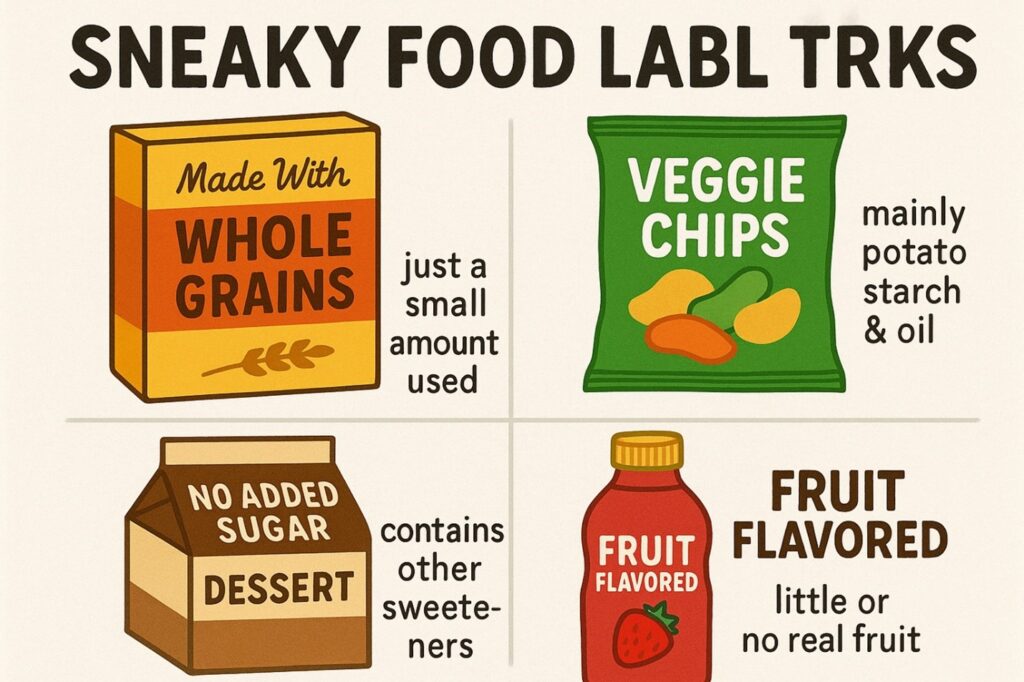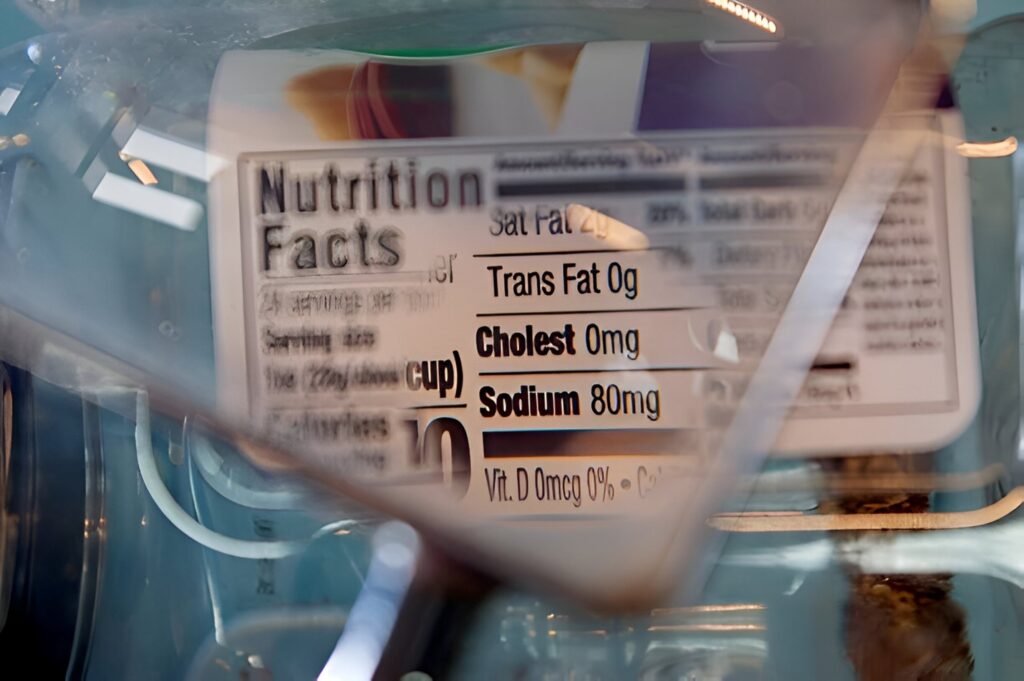Have you ever picked up something that said healthy and felt guilty later when you found out that it was not? You’re not alone. The food companies always have a way of being skilled at sneaky food label tricks so that their products appear to be what they are not. Even a health-conscious shopper can be easily confused by these labels.
Learning food labels explained correctly can help you wade through marketing jargon and guard your health. In this guide, we are going to find out the Top 5 sneaky food label tricks that could be ruining your health and how to avoid those before they find their way into your cart.

The Hidden Danger of Misleading Food Labels
False food labels are more than irritating; they may affect your health in the long run. An example is that the products that can be promoted as “low-fat” tend to have additional sugar to compensate for the taste. Equally, products bearing the tag “whole grain” can just specify a sprinkling of whole wheat into refined flour.
Food producers understand that the fine print of shopping is not the case. They instead depend on words that will catch the attention, such as “natural” or “organic.” Whereas all these assertions are factual regarding some products, many others are not. Learning how to spot food label red flags can help ensure you are making healthy food decisions.
To learn more of our science-based nutrition advice, visit Healthabulous, where we decode the reality behind popular wellness choices.
Sneaky Food Label Trick #1: The “Low-Fat” or “Fat-Free” Trap
However, many individuals believe that low-fat is healthier. Yet, it is among the time-tested food label secrets within the industry. Companies usually fill the empty fat with sugar, refined carbs, or artificial flavor. The result? You can wind up losing more calories than the full-fat variation.
To illustrate, a product termed as fat-free yogurt may still provide more sugar than ordinary yogurt. Research indicates that high-content diets in added sugar lead to obesity, heart disease, and type 2 diabetes. In the case of low-fat, just invert the package and look at the sugar level.
Sneaky Food Label Trick #2: “Made with Whole Grains”
Whole grains are beneficial, but the problem is that most items labeled as ‘made with whole grains’ actually use predominantly refined flour. This claim can only require companies to add a small percentage of whole grains.
This misleading health claim on food packaging deceives consumers into thinking that they are buying a product high in fiber. You might be eating almost no fiber or a lot of processed foodstuffs. The best way to know? Find the ones that have “whole grain” or “whole wheat” as the initial ingredient on a label.
Sneaky Food Label Trick #3: “No Added Sugar” Doesn’t Mean Sugar-Free
This one appears healthy at first sight. A product that says no added sugar might be full of natural sugars, fruit concentrates, or other sweeteners. For example, fruit juices often carry this label but can still cause a spike in blood sugar levels.
It is a typical example of food labeling and hidden sugars. To avoid the claim of added sugar, companies prefer naturally sweet ingredients. Although it is true, this does not imply that this product is healthy. When sugar is among the initial few items of the list or in case there is more than one or two kinds of sweeteners identified on the label, it’s a red flag.
Sneaky Food Label Trick #4: The “Natural” Illusion
The word “natural” is one of the most misleading food labels. This is why several individuals believe that this indicates the commodity does not contain chemicals or artificial additives. The FDA, unfortunately, does not have a strict definition of natural. This implies that companies will be allowed to use it even when their products include preservatives, processed sugar, or unhealthy oils.
As an example, “all-natural” potato chips can still be cooked in refined oils and are high in sodium. Although the ingredients can be said to be of natural origin, the product can be anything but healthy. To prevent being misled by this trap, one should always ensure that they review the list of ingredients rather than relying on the buzzwords used in marketing.
Sneaky Food Label Trick #5: Misleading Serving Sizes
Food companies have employed another strategy by reducing the serving size to make nutrition facts appear healthier. A soda bottle can have something like 110 calories per serving printed on it; however, in small print, it will indicate that the can contains 2.5 servings. Drink it, and you have consumed nearly 300 calories with added sugar.
This is one of the most overlooked food label red flags. Firms understand that a majority of buyers look at labels casually. Always verify the number of servings in the package and change the values to those of the food you are going to eat.
How to Read Food Labels Correctly
It is not about them reading all the nutrients on the food labels; it is about them avoiding the pitfalls. The following are some simple strategies:
- Always search the ingredient list. When refined flour, sugar, or hydrogenated oils are at the top of the list, it signals a red flag.
- Look at serving sizes. Always multiply the figures by how much you actually consume.
- Watch for hidden sugars. Sugar is referred to as “cane juice”, “syrup”, or “concentrate” among others.
- Do not trust what is on the package. Invert the box and look at the details.
These steps will keep you out of some of the common food label mistakes and help you purchase healthier choices.

Healthy Grocery Shopping Tips
Shopping at the grocery store does not need to be complicated. Three basic tips to guard against sneaky food label tricks are as follows:
- Shop the perimeter. Fresh produce, whole grains, and proteins are usually around the store’s edges, while heavily processed foods dominate the middle aisles.
- Stick to whole foods. Foods with fewer ingredients are usually the safest choice.
- Use apps to scan labels. Some of the best apps to scan food labels in 2025 can help you instantly identify red flags and healthier alternatives.
To see additional clean eating tricks, visit Healthabulous, where we deconstruct applicable instructions on how to eat better.
Conclusion
Food companies have mastered the art of sneaky food label tricks so that they can present unhealthy foods as healthier foods. What started with selling low-fat can cause your ruin, like these tricks with misleading labels on a misleading serving size can.
The good news? Now that you have a sense of what to consult, you are in control. Shopping smart and being health-conscious can save you and your health by reading the ingredient list, being aware of the portion size you are eating, and being on the lookout for false health claims in food packaging.
Keep in mind that the most powerful protection you have is your knowledge. Ready to begin using these tips on your next grocery run, and you will be halfway there, eating healthier, without feeling lost.
FAQs About Food Label Tricks
1. What’s the most common food label trick?
One of the most deceptive labels is the “low-fat” label. To substitute fat, companies sometimes use sugar or refined carbs.
2. Are organic labels always trustworthy?
Organic labels are regulated, but “organic” does not imply healthy alone. Organic cookies are still cookies.
3. How can I spot hidden sugars on labels?
Find such words as syrup, juice concentrate, or cane sugar. These are disguised calories that are sugars.
4. Why are serving sizes often misleading?
To reduce calorie, sugar, or fat counts, companies reduce serving sizes to appear smaller. Remember to look at the number of servings on a package.
5. What’s the easiest way to avoid food label tricks?
Prefer whole foods where appropriate and scan ingredient labels to confirm what is on packaged products with the help of label-scanning apps.


